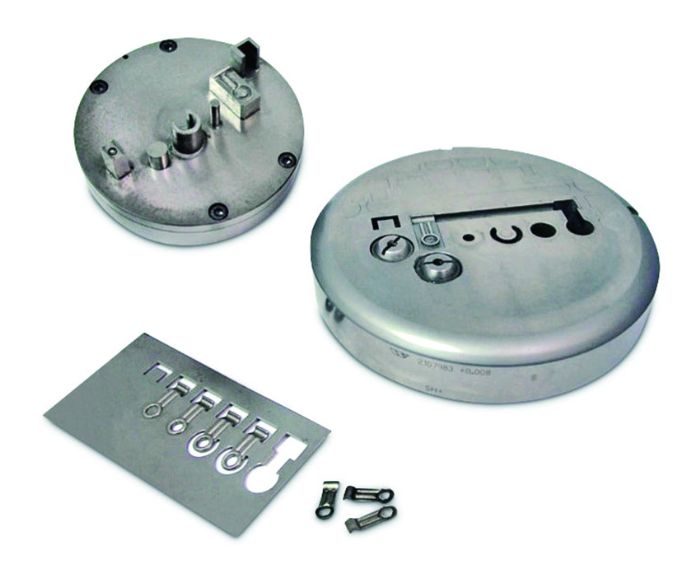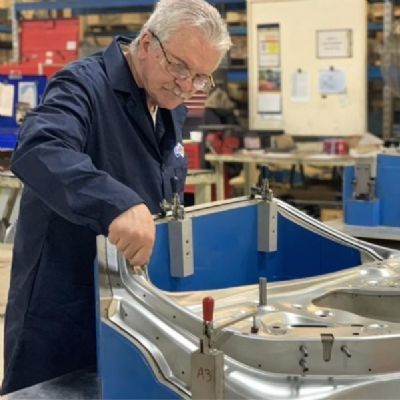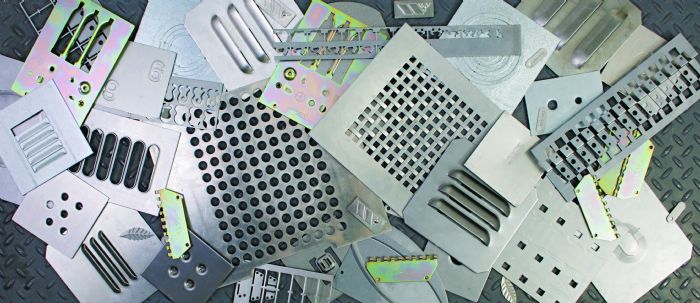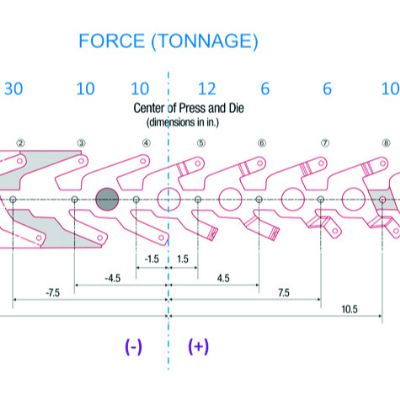The selection of the right tool steel is critical in AHSS punching. Traditional high-speed steels (HSS) may not possess the necessary hardness and toughness to withstand the demanding conditions. Modern tool-steel options, such as powder metal high-speed steels (PM-HSS), optimize performance. Today’s variety of powder metal options allows fabricators to find the right grade for the application and for the steel grade being punched or formed.
PM-HSS offers a homogeneous microstructure with fine, evenly distributed carbides. This translates to improved wear resistance, toughness and grindability compared to conventional HSS grades. PM-HSS grades with high vanadium or cobalt content are particularly well-suited for AHSS punching. These grades can vary between wear resistance, a focus on toughness, or a hybrid approach with some improvements in both areas.
PM-HSS grades with higher percentages of cobalt and tungsten will provide improved wear resistance and improved tool life. With higher hardness and improved compressive strength, these tool-steel grades often get the call for AHSS applications.
 High-toughness PM-HSS grades, with added chromium and molybdenum along with higher amounts of vanadium, provide a tougher punch. Tools from these tool-steel grades can withstand more impact from AHSS materials, and in particular will exhibit reduced micro-fracturing of the cutting edge, which often looks like wear or galling on the punch surface.
High-toughness PM-HSS grades, with added chromium and molybdenum along with higher amounts of vanadium, provide a tougher punch. Tools from these tool-steel grades can withstand more impact from AHSS materials, and in particular will exhibit reduced micro-fracturing of the cutting edge, which often looks like wear or galling on the punch surface.
Combating Wear: Maximize Production Efficiency
AHSS punching generates significant friction and heat, which can lead to rapid tool wear. Minimizing wear is critical for maintaining consistent hole quality and optimizing production efficiency.
To limit heat buildup, fabricators call on tools that have added physical vapor deposition (PVD) coatings, which have tremendous impact on tooling performance in AHSS punching. These ultra-thin coatings offer exceptional hardness, lubricity and adhesion. The coatings act as a barrier between steel-on-steel during piercing and stripping.
- PVD coatings such as titanium nitride and diamond-like carbon reduce friction between the punch and workpiece, minimizing heat generation and material adhesion. This leads to smoother shearing, reduced burring and improved hole quality.
- PVD coatings such as titanium carbo-nitride increase the surface hardness of the punch and die, providing exceptional wear resistance. This translates to longer tool life, reduced tooling cost and fewer production interruptions.
While PVD coatings enhance lubricity, proper lubrication remains essential. High-performance lubricants designed for AHSS punching can further reduce friction and heat, extending tool life and improving hole quality.
Finally, AHSS is prone to work hardening, where the material becomes harder and more brittle as it deforms. This can lead to increased punching force and reduced tool life. Additionally, the grain direction of the material can influence its shearing behavior. Fabricators must carefully consider these factors during part design and material selection.
Case in Point: Improving Airflow
Beyond basic hole punching, AHSS frequently find use in parts designed for airflow management, incorporating complex features such as louvers and custom hole patterns. Forming louvers in AHSS requires precise control of the forming process to prevent cracking and ensure consistent louver geometry. Specialized tooling designs, incorporating progressive forming steps and sharp cutting edges, prove essential.
Creating complex hole patterns in AHSS can be challenging due to the increased punching force and potential for distortion. Advanced tooling designs, such as staggered cluster punches and hole layout, can optimize the punching process and ensure accurate hole placement.
Whether incorporating louvers or custom hole patterns, fabricators must work to design products that optimize airflow efficiency. A useful tool here: computational-fluid-dynamics simulations, which analyze airflow patterns and optimize the design.
In the end, successful punching of AHSS requires a comprehensive approach that addresses the material’s unique properties. By implementing advanced tooling designs, leveraging high-performance tool steels and employing effective wear-reduction techniques, manufacturers can overcome the challenges of AHSS punching and unlock its full potential.
The strategic implementation of PVD coatings for lubricity and hardness, coupled with careful consideration of work hardening and grain direction, ensures optimal results. MF
Article provided by Wilson Tool Intl., White Bear Lake, MN.
View Glossary of Metalforming Terms
See also: Wilson Tool International
Technologies: CNC Punching, Materials
Comments
Must be logged in to post a comment. Sign in or Create an Account
There are no comments posted. Stamping Presses
Stamping PressesSecond-Gen Michigan Stamper Proves Out Her Mettle Through Pr...
Kate Bachman December 9, 2024
 CNC Punching
CNC PunchingScotchman Industries Names Kent Bradley Director of Marketin...
Tuesday, February 25, 2025






 The core of effective AHSS punching lies in understanding and adapting to the formidable strength characteristics of the materials. Traditional tooling designs, optimized for milder steels, often can prove inadequate. The increased force required to shear AHSS demands robust tooling capable of withstanding extreme stress.
The core of effective AHSS punching lies in understanding and adapting to the formidable strength characteristics of the materials. Traditional tooling designs, optimized for milder steels, often can prove inadequate. The increased force required to shear AHSS demands robust tooling capable of withstanding extreme stress. 